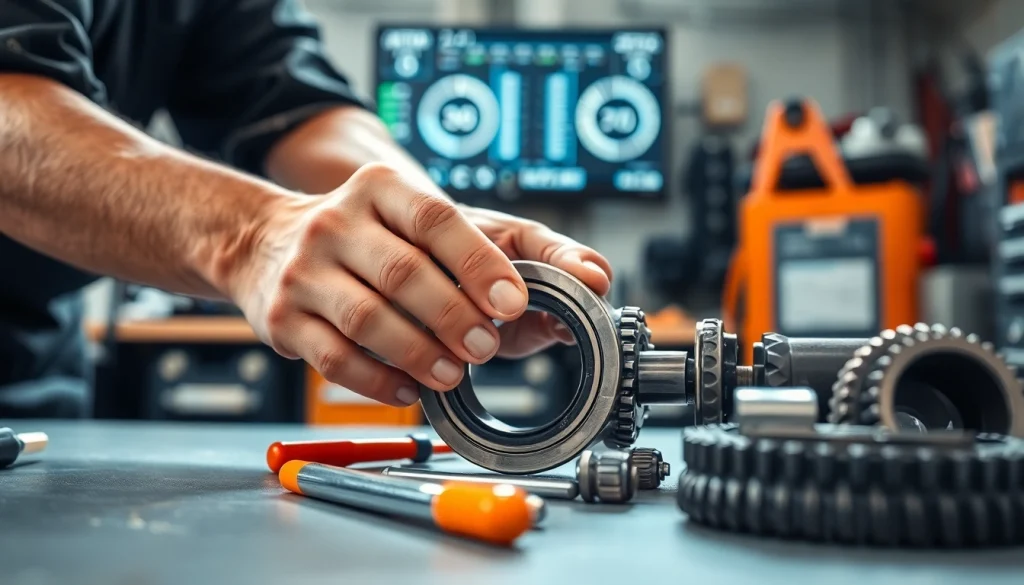Understanding Gearbox Bearings
What Are Gearbox Bearings?
Gearbox bearings are critical components within a vehicle’s transmission system, designed to support and facilitate the smooth rotation of various mechanical parts. Typically composed of steel or ceramic, these bearings reduce friction and wear by enabling efficient motion between moving parts, allowing for an effective transfer of power from the engine to the wheels. Depending on the application, gearbox bearings come in various types, including ball bearings, roller bearings, and needle bearings, each selected based on their specific mechanical properties and intended use.
Common Issues with Gearbox Bearings
Like all mechanical components, gearbox bearings can experience issues over time. Common problems include:
- Wear and Tear: Continuous use leads to fatigue in material, which can result in diminished performance.
- Contamination: Dirt, debris, or moisture entering the bearing can lead to pitting and failure.
- Misalignment: Improper installation or wear on other components can cause the bearings to operate incorrectly, leading to excessive friction.
- Overheating: Insufficient lubrication can cause bearings to heat up, resulting in premature failure.
Importance of Timely Gearbox Bearing Replacement
Timely replacement of worn or damaged gearbox bearings is crucial. Neglecting to address bearing issues can lead to significant problems, such as:
- Increased Repair Costs: A minor bearing issue can escalate into major transmission failure.
- Decreased Performance: Worn bearings can lead to power loss and inefficiency.
- Safety Risks: A failing gearbox can lead to dangerous driving conditions.
For those experiencing problems with their gearbox bearings, it’s advisable to consider gearbox bearing replacement as part of regular vehicle maintenance.
Signs Your Gearbox Bearings Need Replacement
Unusual Noises Indicating Bearing Wear
One of the first indicators that gearbox bearings are failing is the presence of unusual noises. These can range from grinding and whining to knocking sounds. Such noises often suggest that the bearings are either worn or experiencing improper alignment, leading to excessive play in the gearbox.
Fluid Leaks and Their Implications
Fluid leaks around the gearbox can signal a problem with the seals or the bearings themselves. Transmission fluid is crucial for lubrication and cooling, and a decrease in fluid levels can lead to overheating and rapid wear of components.
Performance Indicators for Gearbox Issues
Pay attention to the vehicle’s performance. Notable changes in shifting patterns, sluggish acceleration, or erratic behavior can indicate that the gearbox bearings are not performing optimally. If the vehicle struggles to change gears smoothly, it’s time to investigate further.
Steps for Gearbox Bearing Replacement
Essential Tools and Equipment Required
Before embarking on a gearbox bearing replacement, ensure you have the right tools. These typically include:
- Socket set
- Torque wrench
- Screwdrivers
- Pullers
- Lifting mechanisms (jack, jack stands)
- New bearings
- Cleaning solvents and lubricants
Step-by-Step Replacement Process
Replacing gearbox bearings involves several steps:
- Begin by safely lifting the vehicle and securing it on jack stands.
- Remove the gearbox from the vehicle by detaching all relevant components, including the drive shaft and transmission mounts.
- Once disconnected, clean the gearbox thoroughly to prevent contamination of new bearings.
- Carefully remove the old bearings using appropriate tools.
- Install new bearings, ensuring they are seated correctly and lubricated as per manufacturer guidelines.
- Reassemble the gearbox and reinstall it in the vehicle, double-checking all connections and seals.
- Lower the vehicle, refuel with transmission fluid, and conduct a test drive to verify the successful replacement.
Tips for Ensuring a Successful Replacement
To enhance the likelihood of success during the gearbox bearing replacement, consider these tips:
- Follow Manufacturer Instructions: Always refer to the vehicle service manual.
- Take Your Time: Hasty work can lead to mistakes that will require rework.
- Consult Experts: If unsure, consult with professionals for assistance.
Choosing the Right Replacement Bearings
Types of Bearings You Should Consider
When selecting replacement bearings, consider the following types:
- Ball Bearings: Known for their simplicity and effectiveness in load distribution.
- Roller Bearings: Offer higher load capacities, suitable for high-torque applications.
- Needle Bearings: Ideal for compact spaces, providing low friction and high load support.
Factors Influencing Bearing Selection
Multiple factors can influence your choice of bearing:
- Load Capacity: Identify the maximum weight or force the bearing must endure.
- Operating Temperature: Ensure the material can withstand the temperature range in which it will operate.
- Speed Ratings: Bearings must be rated for the speed at which the engine operates to prevent failure.
Best Practices for Sourcing Quality Bearings
When sourcing bearings, prioritize purchasing from reputable manufacturers to ensure quality and performance standards are met. Check for certifications and reviews to avoid counterfeits, which could lead to premature failure.
Maintenance Tips Post-Replacement
How to Care for Your New Bearings
Proper care for new bearings is vital to extending their lifespan:
- Regular Lubrication: Maintain proper lubrication levels to prevent wear.
- Avoid Overloading: Be mindful of vehicle loads for weight distribution.
Regular Inspection Protocols
Establish a routine for inspecting your gearbox bearings, including:
- Listening for unusual noises while driving.
- Monitoring fluid levels for leaks.
- Checking for any visible signs of wear or misalignment.
When to Seek Professional Help
If you encounter persistent issues or are unsure of the condition of your bearings, do not hesitate to consult a professional. Expert assessments can save time and avoid costly mistakes in the long run.
